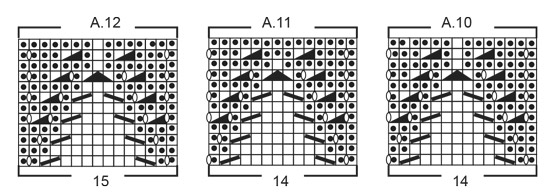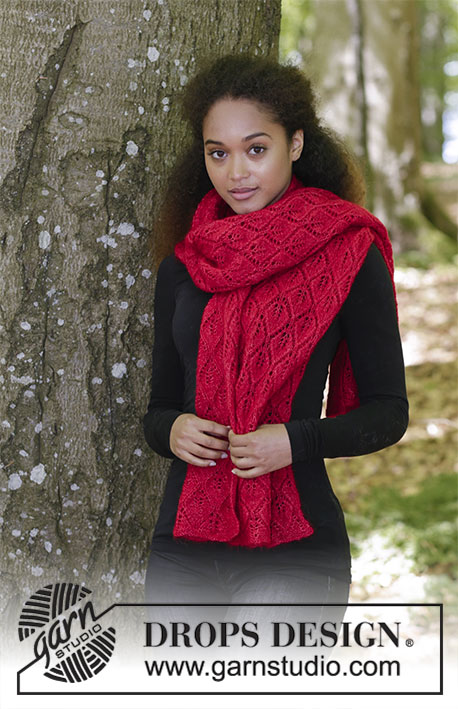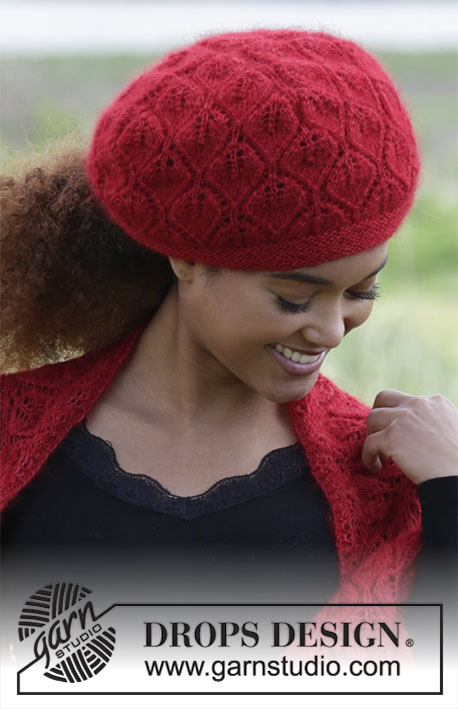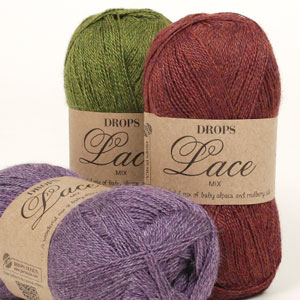Hot Coal |
|||||||||||||||||||||||||
 |
 |
||||||||||||||||||||||||
Set consists of: Knitted scarf and hat with lace pattern. Set is worked in DROPS Lace and DROPS Kid-Silk.
DROPS 183-7 |
|||||||||||||||||||||||||
|
INFORMATION FOR PATTERN: GARTER STITCH (back and forth): 1 ridge = knit 2 rows. GARTER STITCH (worked in the round): 1 ridge = 2 rounds. Knit 1 round and purl 1 round. PATTERN: Scarf: See diagrams A.1 to A.12. Hat: See diagrams A.1 and A.13 to A.15. Diagrams show all rows in pattern seen from the right side. BIND-OFF TIP: To avoid a tight bind-off edge you may use a needle ½ size larger. ---------------------------------------------------------- SCARF: Worked in the round in a square on double pointed needles/circular needle, begin from the middle of scarf. When square is done, the width of scarf is done and bind off in 2 of the sides. Then work back and forth out to each of the 2 other sides. Cast on 12 stitches on double pointed needles size 3 mm / US 2.5 with 1 strand Lace and 1 strand Kid-Silk (= 2 strands). * Knit 1, 1 yarn over, knit 1, purl 1 *, work from *-* 4 times in total on round (on next round work yarn overs twisted to avoid holes) = 16 stitches. Work pattern in the round according to diagram A.1 4 times in total on round - read PATTERN above. Switch to circular needle when needed. REMEMBER THE GAUGE! When entire diagram A.1 has been worked, there are 128 stitches on round. Insert 4 markers without working as follows: Insert first marker at beginning of round, insert second marker after 32 stitches, insert third marker after 32 stitches and insert 4th marker after 32 stitches, move markers upwards when working. Now work pattern as follows: Work * A.2 (= 2 stitches), A.3 over the next 28 stitches (= 2 repetitions of 14 stitches) and A.4 (= 2 stitches) *, work from *-* 4 times in total on round. When A.2/A.3/A.4 are done vertically, there are 60 stitches between each marker (= 240 stitches on round). Now work pattern as follows: Work * A.2 (= 2 stitches), A.3 over the next 56 stitches (= 4 repetitions of 14 stitches) and A.4 (= 2 stitches) *, work from *-* 4 times in total on round. When A.2/A.3/A.4 are done vertically, there are 88 stitches between each marker (= 352 stitches on round). Now work pattern as follows: Work * A.2 (= 2 stitches), A.3 over the next 84 stitches (= 6 repetitions of 14 stitches) and A.4 (= 2 stitches) *, work from *-* 4 times in total on round. Continue this pattern to and with 12th round (= round with arrow in diagrams). There are now 102 stitches between each marker (= 408 stitches on round). Then work pattern as follows: * continue on 13th round in A.2/A.3/A.4 until next marker, work A.5 (= 9 stitches), A.6 over the next 84 stitches (= 6 repetitions of 14 stitches), A.7 (= 9 stitches), marker *, work from *-* 2 times in total. Continue this pattern until 2 rounds remain in diagrams. Work next round in pattern but skip the first 2 yarn overs in A.2 and skip last yarn over in A.4 (see star in diagrams). Work last round in pattern as follows: NOTE! Skip the first 2 squares in A.2 and skip last square in A.4 - work from first to second marker and slip the 113 stitches on 1 stitch holder (= part-1), work until third marker and slip the 113 stitches on 1 stitch holder (= side), work until fourth marker and slip the 113 stitches on 1 stitch holder (= part- 2), work until first marker = 113 stitches on needle (= side). Work rib (= knit 1/purl 1) with 1 edge stitch in garter stitch in each side over these stitches for 1½ cm / ½". Loosely bind off - read BIND-OFF TIP above. Slip the 113 stitches from the other side (= from second to third marker) on circular needle size 3 mm / US 2.5. Begin from wrong side and work rib (= knit 1/purl 1) with 1 edge stitch in garter stitch in each side over these stitches for 1½ cm / ½". Loosely bind off. Square measures approx. 50 cm / 19¾" in width and 47 cm / 18½" vertically. PART-1: Work piece back and forth on circular needle. Slip the 113 stitches from part-1 on circular needle size 3 mm / US 2.5 and insert 1 marker - NOW MEASURE PIECE FROM HERE! Beginning from right side and work as follows: Pick up 4 stitches at the edge of ridges on the side, work A.8 (= 14 stitches), work A.3 over the next 84 stitches (= 6 repetitions of 14 stitches), work A.9 (= 15 stitches) and pick up 4 stitches in the side of ridges on the side = 121 stitches. Continue the 4 stitches in each side in garter stitch. Continue this pattern until piece measures approx. 47 cm / 18½", adjust after one whole repetition vertically. Now work pattern as follows from right side: Work 4 stitches in garter stitch, A.10 (= 14 stitches), A.11 over the next 84 stitches (= 6 repetitions of 14 stitches), A.12 (= 15 stitches) and 4 stitches in garter stitch. When diagram is done vertically, work 2 ridges and loosely bind off. Piece measures approx. 52 cm / 20½". PART-2: Work as part-1. I.e. slip the 113 stitches from part-2 on circular needle size 3 mm / US 2.5 and insert 1 marker. Begin by picking up stitches in the side of ridges and work pattern as on part-1. ---------------------------------------------------------- HAT: Work hat in the round in a square on double pointed needles/a short circular needle, top down. Cast on 12 stitches on double pointed needles size 3 mm / US 2.5 with 1 strand Lace and 1 strand Kid-Silk (= 2 strands). * Knit 1, 1 yarn over, knit 1, purl 1 *, work from *-* 4 times in total on round (on next round work yarn overs twisted to avoid holes) = 16 stitches. Work pattern in the round according to diagram A.1 4 times in total on round - read PATTERN above. Switch to circular needle when needed. REMEMBER THE GAUGE! When entire diagrams A.1 has been worked, there are 128 stitches on round. Now work pattern as follows: Work * A.13 (= 3 stitches), A.14 (= 14 stitches) and A.15 (= 15 stitches) *, work from *-* 4 times in total on round. When diagrams have been worked vertically, there are 168 stitches on needle. Displace the beginning of the round 1 stitch to the left. Then work pattern as follows: Work A.14 over all stitches (= 12 repetitions of 14 stitches). Work diagram 1 time vertically. Knit 1 round while at the same time decreasing 46 stitches evenly = 122 stitches. Work in GARTER STITCH - see explanation above, for 3 cm / 1" and loosely bind off - read BIND-OFF TIP above. Piece measures approx. 24 cm / 9½". |
|||||||||||||||||||||||||
Diagram explanations |
|||||||||||||||||||||||||
|
|||||||||||||||||||||||||

|
|||||||||||||||||||||||||

|
|||||||||||||||||||||||||

|
|||||||||||||||||||||||||

|
|||||||||||||||||||||||||
|
Have you made this or any other of our designs? Tag your pictures in social media with #dropsdesign so we can see them! Do you need help with this pattern?You'll find tutorial videos, a Comments/Questions area and more by visiting the pattern on garnstudio.com. © 1982-2024 DROPS Design A/S. We reserve all rights. This document, including all its sub-sections, has copyrights. Read more about what you can do with our patterns at the bottom of each pattern on our site. |
|||||||||||||||||||||||||






































































Comments / Questions (37)
Re Bonjour Je vous remercie pour votre réponse si rapide et attend avec impatience la solution car ce modèle est très agréable à tricoter , de plus c'est un cadeau pour ma fille qui a flashé sur l'ensemble ps j'ai lu les commentaires sur l'écharpe avant que je me lance avez vous une version corrigée ?? encore merci martine
23.02.2021 - 10:55DROPS Design answered:
Bonjour Mme Calle, la correction date de 2019, si vous venez d'imprimer les explications, le modèle et les diagrammes sont justes. Bon tricot!
23.02.2021 - 12:34Je suis en panne sur le bonnet , je suis bloquée sur la 12eme ligne du groupe 13 -14 -15 qui ne correspond pas au nombre de mailles ni au profil du dessin pouvez vous me dépanner assez vite merci d'avance
23.02.2021 - 08:36DROPS Design answered:
Bonjour Mme Callé, effectivement, il semble y avoir un jeté en trop dans A.15, nos stylistes vont vérifier le diagramme dès que possible. Merci d'avance pour votre patience.
23.02.2021 - 09:12Hallo, bei den letzten beiden Runden im Quadrat sollten sie beiden Umschläge am Anfang und am Ende A2 und A4 nicht gestrickt werden. Was ist mit den beiden Abschnitten, auf denen ich A5 und A7 stricke? Sollen die 3 Umschläge da auch weggelassen werden? Danke für die Antwort schon mal! Barbara
27.01.2021 - 09:07DROPS Design answered:
Liebe Barbara, die Maschen zwischen den 2. und 3. Markierer werden im Bündchen gestrickt. dh wie die letzten 113 letzten Maschen. Der Tuch wird dann in 2 Teile von den Maschen in A.2-A.4 weiter gestrickt. Viel Spaß beim stricken!
27.01.2021 - 13:08Hallo. In der Anleitung zum Schal steht gleich am Anfang, dass man die Umschläge im der Rückrunde verschränkt stricken soll, um Löcher zu vermeiden. Ist das nur für die erste Runde oder in jeder Runde nach Umschlägen?
14.12.2020 - 13:12DROPS Design answered:
Liebe Doreen, ja genau, nur die Umschläge der 1. Runde werden verschränkt gestrickt, die Umschläge von Diagrammen werden ganz "normal" gestrickt, um das Loch- bzw Blättermuster zu bilden. Viel Spaß beim stricken!
14.12.2020 - 13:39Bonjour, Je veux juste me servir de ce modèle pour reproduire le motif pour un pull. Quel diagramme choisir pour avoir le motif complet ? Merci d'avance. Bien cordialement. Annie
25.11.2020 - 18:13DROPS Design answered:
Bonjour Annie, tout dépend de votre tension, de la taille, de la forme, des mesures etc... vous trouverez ici différents modèles de pulls au point de feuilles, ils pourront probablement vous inspirer. Bon tricot!
26.11.2020 - 09:42Dank U, door het weglaten van de omslagen zoals u ook aangeeft, heb ik de muts succesvol gebreidf.
19.11.2020 - 14:11Ik heb de eerste en laatste omslag weggelaten. Ik hoop dat daarmee het probleem opgelost wordt.
05.11.2020 - 19:02Bij de muts klopt het schema nie in A15. Dat is twee keer eerder opgemerkt, bij 1 ontkent u dat. Ik weet niet hoe verder. In tour 11 eindigt,zoals alle naalden,op een omslag en een averecht stk. In nld 12, komen de laatste omslag en averechts steek van A15 niet meer voor. In totaal v a n A13,14 en 15, geteld in nld 11 is 44stk. nld 12 42stk. HELP svp. Dank u, de sjaal heb ik al gemaakt en is prachtig!
05.11.2020 - 18:46DROPS Design answered:
Dag Bianca,
De telpatronen heb ik nog eens grondig nagekeken en ik denk dat er inderdaad iets niet klopt op de 11e toer. Mijn idee is dat de eerste omslag van A.13 en de laatste omslag van A.15 moet komen te vervallen. Dit heb ik doorgegeven aan de ontwerpafdeling ter controle, dus ik hoop dat er spoedig een correctie op het patroon komt, zodat je verder kunt.
19.11.2020 - 11:12How many balls of this yarn to make a shawl like this please? Thank you
19.03.2020 - 11:03DROPS Design answered:
Dear Mrs Gueganton, you will find required yarn amount under header - read more here. Happy knitting!
19.03.2020 - 11:53Ben wel teleurgesteld dat ik geen antwoord heb gekregen op mijn vraag van 14-12-19. Heb het zelf opgelost. In naald 21 brei ik nu de eerste 2 steken van A8 samen en de laatste 2 steken van A9 ook (1 afhalen, 1 recht, overhalen). Dan staan er aan het eind weer 113 steken op de naald (rand van ribbels niet meegerekend). Let op, dit geldt dus alleen voor deel 1 en deel 2 van de sjaal als je A8, A3, A9 aan het breien bent.
18.01.2020 - 09:42